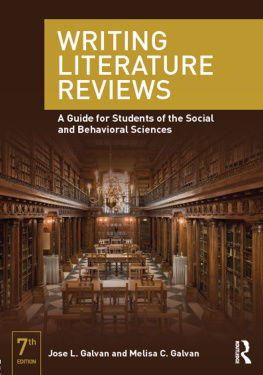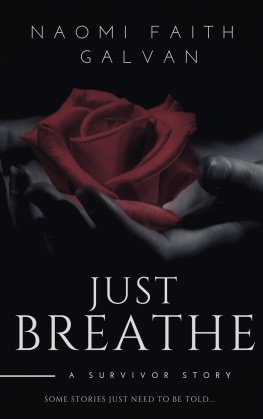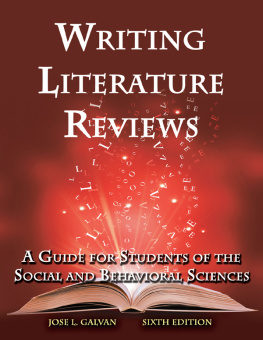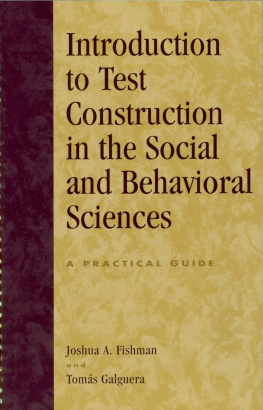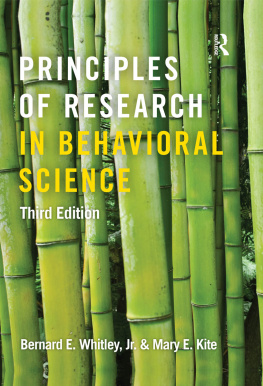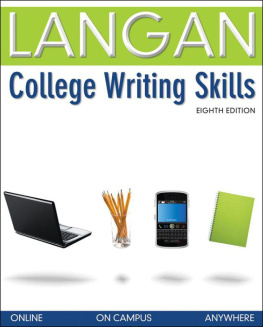Contents
Page List
Guide

Writing Literature Reviews
This useful guide educates students in the preparation of literature reviews for term projects, theses, and dissertations. The authors provide numerous examples from published reviews that illustrate the guidelines discussed throughout the book.
New to the seventh edition:
Each chapter breaks down the larger holistic review of literature exercise into a series of smaller, manageable steps
Practical instructions for navigating todays digital libraries
Comprehensive discussions about digital tools, including bibliographic and plagiarism detection software
Chapter activities that reflect the books updated content
New model literature reviews
Online resources designed to help instructors plan and teach their courses (www.routledge.com/9780415315746).
Jose L. Galvan (Ph.D., 1980, UT Austin) is Professor Emeritus at California State University, Los Angeles. His academic career spans 39 years, including appointments at UCLA; Teachers College, Columbia University; California State University, Los Angeles; and San Francisco State University.
Melisa C. Galvan (Ph.D., 2013, UC Berkeley) is Assistant Professor at California State University, Northridge.
Writing Literature Reviews
A Guide for Students of the Social and Behavioral Sciences
Seventh Edition
Jose L. Galvan and Melisa C. Galvan

Seventh edition published 2017
by Routledge
711 Third Avenue, New York, NY 10017
and by Routledge
2 Park Square, Milton Park, Abingdon, Oxon, OX14 4RN
Routledge is an imprint of the Taylor & Francis Group, an informa business
2017 Taylor & Francis
The right of Jose L. Galvan and Melisa C. Galvan to be identified as the authors of this work has been asserted by them in accordance with sections 77 and 78 of the Copyright, Designs and Patents Act 1988.
All rights reserved. No part of this book may be reprinted or reproduced or utilised in any form or by any electronic, mechanical, or other means, now known or hereafter invented, including photocopying and recording, or in any information storage or retrieval system, without permission in writing from the publishers.
Trademark notice: Product or corporate names may be trademarks or registered trademarks, and are used only for identification and explanation without intent to infringe.
First edition published by Pyrczak Publications 1999
Sixth edition published by Routledge 2014
Library of Congress Cataloging in Publication Data
Names: Galvan, Jose L., author. | Galvan, Melisa, author.
Title: Writing literature reviews : a guide for students of the social and behavioral sciences / Jose Galvan and Melisa Galvan.
Description: Seventh edition. | New York, NY : Routledge, 2017. | Includes bibliographical references.
Identifiers: LCCN 2016044168| ISBN 9781138294219 (hardback) | ISBN 9780415315746 (pbk.) | ISBN 9781315229386 (ebook) Subjects: LCSH: Social sciencesResearch. | Social sciences Authorship. | PsychologyResearch. | Scholarly periodicals. | Academic writing. | Book reviewing.
Classification: LCC H62 .G246 2017 | DDC 808.06/63dc23 LC record available at https://lccn.loc.gov/2016044168
ISBN: 978-1-138-29421-9 (hbk)
ISBN: 978-0-415-31574-6 (pbk)
ISBN: 978-1-315-22938-6 (ebk)
Typeset in Bembo and Trade Gothic
by Florence Production Ltd, Stoodleigh, Devon, UK
To our friend, Dr. Fred Pyrczak, 19452014.
Contents
This book was designed to provide students with practical guidelines for the complex process of writing literature reviews in the social and behavioral sciences.
When Writing Literature Reviews was first published in 1999, university libraries had just begun to adopt digital search tools to assist with surveying the available research literature, but at the time most journals were still available only in print form. Today, by contrast, the contemporary university library is almost entirely digital, and this edition of Writing Literature Reviews has been recast to reflect this new digital landscape.
The authors daughter, now a university professor herself and a new co-author of Writing Literature Reviews, is a product of the modern digital library, and she has lent her expertise with digital databases and her recent experience in completing a doctoral dissertation to reframe the books content. The result is a thorough rewriting and updating of the book, starting with the steps involved in searching databases, keeping track of citations, organizing the details gleaned from the literature surveyed, and producing a reference list or bibliography, all of which were rewritten to reflect the modern librarys digital landscapes.
The seventh edition of Writing Literature Reviews maintains its primary focus on reviewing original research published in academic journals and on its relationship to theoretical literature. However, most of the guidelines presented here can also be applied to reviews of other kinds of source materials, and feedback received from readers in other fields suggests that the guidelines presented here can easily be applied across the curriculum. In fact, our book has been adopted for use in a variety of departments representing nearly 100 universities across the U.S., and a Chinese translation was published in 2012 for use in universities in Taiwan and mainland China.
There are three main audiences for Writing Literature Reviews.
First, this book was written for students who are asked to write literature reviews as term papers in content-area classes in the social and behavioral sciences. Often, their previous training has not prepared them for the complex task of reviewing existing research reports to produce a cohesive essay with an original point of view. Lower-division college students need guidance in learning to search databases for reports of original research and related theoretical literature, to analyze these particular types of literature, and to synthesize them into cohesive narratives. In high school, they may have relied on secondary sources such as encyclopedias, reports in the mass media, and books that synthesize the work of others. Now, they need to access the original research reports, and they need to learn the conventions for writing academic papers. This book is designed to fill these gaps by giving students detailed, step-by-step guidance on how to conduct a literature search and how to write comprehensive reviews of primary source materials.
Students beginning to work on their theses and dissertations will also benefit from this book if they have not previously received comprehensive instruction on how to prepare critical analyses of published research and the theories on which it is based. Undertaking a thesis or dissertation is stressful. This book serves as a source of calm and logic as students begin to prepare their literature review chapter.
Finally, individuals preparing to write literature reviews for possible publication in journals as well as those who need to include literature reviews in grant proposals will find that this book can serve as a resource in outlining and identifying the key components for such publications.
The following features make Writing Literature Reviews unique among textbooks designed to teach analytical writing:
Its organization follows a systematic, natural progression of steps that writing instructors refer to as the Writing Process.

